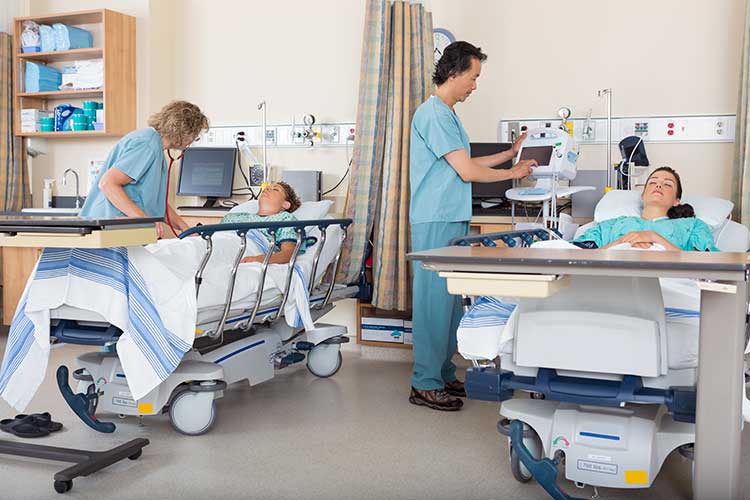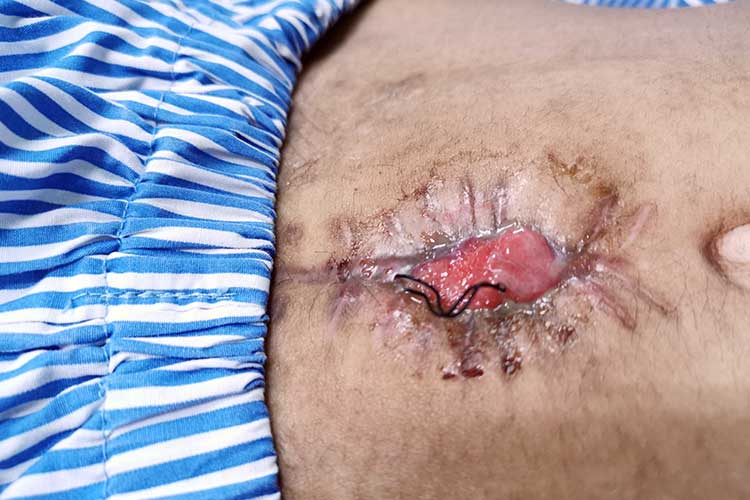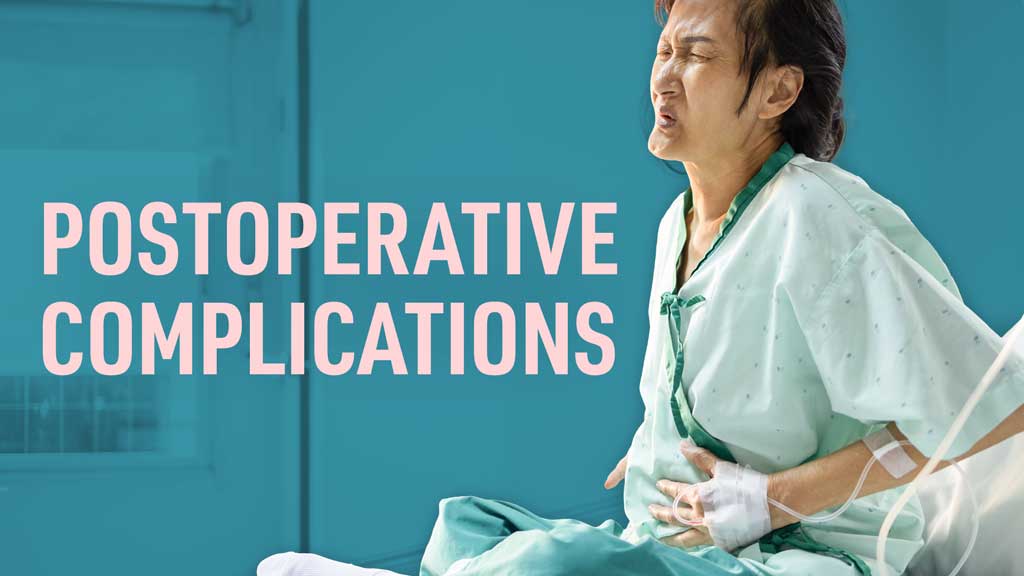Every time a patient undergoes surgery, they are at risk of potential complications.
These can vary from the mild side effects of surgery to major complications that may result in the death of a patient. Postoperative nursing care should involve closely monitoring the patient in order to identify early warning signs and prevent complications from occurring.
Complications vary depending on the surgery being performed, however, many are common across a variety of different procedures.
The following article will provide an overview of some of the postoperative complications that may be experienced by patients.

Nausea and Vomiting
Nausea and vomiting may seem insignificant but can be distressing for the patient (Gan et al. 2020) and delay their discharge home if uncontrolled (Rae 2016).
Postoperatively, expect up to 80% of high-risk patients and 30% of other patients to experience nausea and/or vomiting (Sizemore et al. 2022).
See: Postoperative Nausea and Vomiting
Abdominal Distension and Paralytic Ileus
These two complications are very similar. The patient will complain of abdominal pain and be unable to pass flatus. They may experience nausea and vomiting in addition to a distended abdomen.
These symptoms arise when the intestinal peristalsis slows down or stops, causing the bowel contents to be stagnant. Sometimes it can be prevented with early mobilisation, however, once it occurs, the patient is treated by being nil by mouth, and may also need their gastric contents emptied by insertion of a nasogastric tube (Koutoukidis et al. 2017).
Urinary Retention
There are many factors that may contribute to decreased urinary function following surgery, resulting in urinary retention. These include pain, medicines and a depressed micturition reflex caused by certain anaesthetic agents, spinal anaesthetics or epidurals (Pomajzl & Siref 2023).
Management of urinary retention includes:
- Encouraging ambulation
- Assuming a normal voiding position
- Ensuring adequate fluid intake
- Double voiding
- Providing sensory stimulation such as running water when trying to void
- Catheterisation (as a last resort).
(Koutoukidis et al. 2017)
Constipation
Postoperative constipation is caused by disruption of the patient’s normal diet, reduced mobility, reduced fluid intake, medications such as narcotics and the depressive effects of anaesthetic agents. It is not something to be taken lightly; constipation can potentially lead to bowel obstruction and the patient undergoing further surgeries (Koutoukidis et al. 2017).
Pain
Pain management can be a significant problem for some patients following surgery. People often associate pain with surgery, however, uncontrolled pain can have many negative effects on the patient, including increased risk of morbidity and mortality, delayed recovery and chronic pain (Baratta et al. 2014).
Patients with poor pain control have also been found to be five times more likely to experience an infection due to the stimulating effect pain has on the stress response, impacting both cardiac and immune functions (Baratta et al. 2014; Koutoukidis et al. 2017).
See: Pain Assessment & Management
Shock
Shock is caused by a reduction in the volume of blood circulating through the body. The patient will present with hypotension; weak tachycardia; restlessness; pale, cool and damp skin; and diminished urinary output (Farrell & Dempsey 2013; Koutoukidis et al. 2017).

Haemorrhage
Postoperative haemorrhage can be divided into two categories:
- Reactionary haemorrhage, which occurs within the first 24 hours following surgery and is caused by the dislodgement of clots from vessels.
- Secondary haemorrhage, which results from an infection that weakens the blood clots or the vessel walls.
(Koutoukidis et al. 2017)
Hypoxia
Hypoxia occurs when the blood isn’t carrying enough oxygen for the body’s needs. The tissues and organs require the oxygen from the blood to survive, so hypoxia is a very significant complication.
The hypoxic patient will show signs and symptoms such as:
- Tachycardia
- Tachypnea
- Shortness of breath
- Pallor or cyanosis
- Decreased responsiveness
- Confusion
- Restlessness.
(Bhutta et al. 2022)
Pneumonia
Pneumonia is a common postoperative complication that occurs due to an accumulation of secretions in the lungs, causing lung consolidation and consequently, infection.
The risk of pneumonia can be increased by a variety of factors including high body mass index, smoking, respiratory status, any premorbid respiratory conditions such as COPD, whether the patient needed mechanical ventilation during the postoperative period and the use of opioids. Opioids have a depressive effect on the respiratory system and can place the individual at an increased risk of developing pneumonia (Akhtar et al. 2013; Farrell & Dempsey 2013; Koutoukidis et al. 2017).
Deep Vein Thrombosis (DVT)
DVTs can occur following surgery due to blood becoming stagnant in the veins, or venous stasis. This occurs when the blood needs help to flow back up the legs to the heart. The calf muscles usually act as a pump to do this, but after surgery when the patient is resting in bed for a prolonged period of time, this will not occur and can result in a DVT formation (Koutoukidis et al. 2017; Rothrock 2015).
See: Venous Thromboembolism: Symptoms and Prevention
Pulmonary Embolism
A pulmonary embolism (PE) occurs when one of the pulmonary arteries is blocked by a blood clot, air or fat. The patient will often complain of a sudden onset of dyspnea, chest pain and cyanosis. A PE can result in sudden circulatory collapse and death (Koutoukidis et al. 2017).
See: Chest Pain Assessment: What to Do When Your Patient Has Chest Pain
Wound Infection
Wound infections can also occur in the surgical wound; therefore, it is important that any dressing changes are completed using aseptic technique.
Surgical site infections have many implications including:
- Increased length of stay
- Increased cost of care
- Risk of further complications such as cellulitis and systemic involvement
- Pain and discomfort.
(Zabaglo & Sharman 2023)
See: Wound Care Guide
Wound Dehiscence

Wound dehiscence, wherein a wound opens along the sutures, can be quite traumatic for the patient and is associated with mortality rates as high as 40% (WoundSource 2016; Gillespie et al. 2023).
It may occur due to a variety of factors, including:
- Poor tissue healing from malnutrition
- Obesity
- Anaemia
- Infection
- Premature removal of wound closure
- Stress on the unhealed incision such as straining or coughing.
(Koutoukidis et al. 2017; Van Ramshorst et al. 2010)
See: Wound Care Guide
Postoperative Delirium
Postoperative delirium usually occurs in older adults. It is an acute change in cognition and is usually characterised by:
- Confusion
- Perceptual and cognitive deficits
- Disturbed sleep
- Fluctuating levels of consciousness
- Disorganised thinking
- Altered attention levels.
(Cunningham & Kim 2018)
Interestingly, the incidence of postoperative delirium depends on the type of surgery the patient has undergone, with surgery for hip fractures having a higher incidence of postoperative delirium than other surgeries. This could be due to the urgency related to this surgery and those who fracture their hips often being older adults with multiple comorbidities (Rudolph & Marcantonio 2011).
Conclusion
There are many other potential complications that can occur following any surgery, however, these are some of the most common complications that are associated with a variety of different procedures. As mentioned, these complications can impact the patient in many different ways.
Topics
References
- Akhtar, A, MacFarlane, RJ & Waseem, M 2013, ‘Pre-operative Assessment and Post-operative Care in Elective Shoulder Surgery’, The Open Orthopaedics Journal, vol. 7, no. 3, viewed 7 September 2023, https://www.ncbi.nlm.nih.gov/pmc/articles/PMC3788190/
- Baratta, JL, Schwenk, ES & Viscusi, E 2014, ‘Clinical Consequences of Inadequate Pain Relief: Barriers to Optimal Pain Management’, Plastic and Reconstructive Surgery, vol. 134, no. 4S-2, viewed 7 September 2023, https://journals.lww.com/plasreconsurg/Abstract/2014/10002/Clinical_Consequences_of_Inadequate_Pain_Relief__.5.aspx
- Bhutta, BS, Alghoula, F & Berim, I 2022, ’Hypoxia’, StatPearls, viewed 7 September 2023, https://www.ncbi.nlm.nih.gov/books/NBK482316/
- Cunningham, J & Kim, L D 2018, ‘Post-operative Delirium: A Review of Diagnosis and Treatment Strategies’, Journal of Xiangya Medicine, vol. 3 no. 2, viewed 7 September 2023, http://jxym.amegroups.com/article/view/4361/5185
- Farrell, M & Dempsey, J 2013, Smeltzer and Bare’s Textbook of Medical-Surgical Nursing, 3rd edn, Lippincott Williams & Wilkins, Broadway.
- Gan, TJ et al. 2020, ‘Fourth Consensus Guidelines for the Management of Postoperative Nausea and Vomiting’, Anesthesia & Analgesia, vol. 131, no. 2, viewed 7 September 2023, https://journals.lww.com/anesthesia-analgesia/fulltext/2020/08000/fourth_consensus_guidelines_for_the_management_of.16.aspx
- Gillespie, BM et al. 2023, ‘Incidence of Wound Dehiscencein Patients Undergoing Laparoscopy or Laparotomy: A Systematic Review And Meta-Analysis’, Journal of Wound Care, vol. 32, no. Sup8a, viewed 7 September 2023, https://www.magonlinelibrary.com/doi/abs/10.12968/jowc.2023.32.Sup8a.S31
- Koutoukidis, G, Stainton, K & Hughson, J (eds) 2017, Tabbner’s Nursing Care: Theory and Practice, 7th edn, Elsevier, Chatswood.
- Pomajzl, A & Siref, LE 2023, ‘Postoperative Urinary Retention’, StatPearls, viewed 7 September 2023, https://www.ncbi.nlm.nih.gov/books/NBK549844/
- Rae, A 2016, ‘Reasons for Delayed Patient Discharge Following Day Surgery: A Literature Review’, Nurs Stand., vol. 31 no. 11, viewed 7 September 2023, https://pubmed.ncbi.nlm.nih.gov/27848403/
- Rothrock, JC (ed) 2015, Alexander’s Care of the Patient in Surgery, 15th edn, Elsiver, St Louis.
- Rudolph, JL & Marcantonio, ER 2011, ‘Postoperative Delirium: Acute Change With Long-term Implications’, Anesthesia and Analgesia, vol. 112, no. 5, pp. 1202-1211, viewed 11 September 2020, https://www.ncbi.nlm.nih.gov/pmc/articles/PMC3090222/
- Sizemore, DC, Singh, A, Dua, A, Singh, K & Grose, BW 2022, ‘Postoperative Nausea’, StatPearls, viewed 7 September 2023, https://www.ncbi.nlm.nih.gov/books/NBK500029/
- Van Ramshorst, GH et al. 2010, ‘Abdominal Wound Dehiscence in Adults: Development and Validation of a Risk Model’, World Journal of Surgery, vol. 34, no. 20, viewed 11 September 2020, https://link.springer.com/article/10.1007/s00268-009-0277-y
- WoundSource 2016, What Is Wound Dehiscence?, WoundSource, viewed 7 September 2023, https://www.woundsource.com/blog/what-wound-dehiscence
- Zabaglo, M & Sharman, T 2023, ‘Postoperative Wound Infection’, StatPearls, viewed 7 September 2023, https://www.ncbi.nlm.nih.gov/books/NBK560533/

